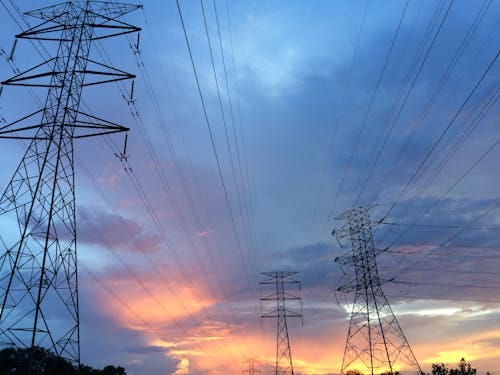1This essay contains a bit more technical detail than my usual efforts.
I remember the last day that I felt I was a child; I had been sliding into a moody adolescence in the early 1980s when a spectacular lighting storm cut off the electricity to our rural Irish house for over 24 hours. While this lasted, I regressed in a house full of pools of darkness outside adult supervision; thrilled by the drama of multiple lighting strikes and thunder. I think that might have been the start of my interest in electricity and my subsequent foray into the electrical power industry.
One of my first (and still my favorite job) was as a laboratory technician in a local factory owned by an American multinational which made electrical circuit breakers and switches for industry and the home markets. As part of the testing process we had to test devices to destruction, which meant simulating lighting strikes on them. This meant spending time in the High Current Laboratory, a thrilling mix of high tech equipment and racks of clunky mechanical circuits reached by clambering up a steel ladder and fettling with heavy spanners and wrenches.
On testing days, we’d lock the lab door, don our helmets and ear protectors, and wait for the senior technician to push the button to release the current, jumping out of our skins at the bang. Afterwards, the charred remains of the device were disassembled and photographed and the oscilloscope read-out torn off from the paper roll to show the peak voltage.
I went to study electrical engineering in Belfast, at a time when the entire tiny Northern Ireland electrical grid was supplied by one power station; when the lights dipped once in a lecture, the lecturer joked ‘They need to put another shovel of coal on the fire in Ballylumford’. (We also managed once in one hair raising botched lab experiment to dip the lights of the entire building, and were ordered by a panicked technician to ‘say nothing’). Outside the laboratories and lecture halls, life elsewhere in Northern Ireland in the late 1980s could be pretty grim, there were soldiers and armed police patrolling the streets and the night a large car bomb went off less than half a mile away is one etched in my memory.
In the late 1980s most of our lives were underpinned by fossil fuels, at home, we threw sods of turf in the Aga; changed the bottled gas canisters for the cooker; switched on our oil boiler; and pumped petrol from pumps at the local shop for our cars. We also switched on the electric lights at home without any thought of how this was powered (much to the disgust of my father, who reminded us that it didn’t grow on trees!). Thanks to my job and studies I knew more than most, but my knowledge was still theoretical until I visited a power station under a Welsh mountain several years after I left university, and saw for the first time the spinning turbines and generators that I had seen so often in the diagrams of my electrical engineering text books.2
Today, electricity is at the forefront of societal changes as our societies turn away from fossil fuels. At the forefront of this has been the push to move more and more aspects of modern life onto electricity, from home heating heat pumps to electrical cars for transport. And this is also the move to a cashless society and the myriad of ways where the internet is inserting itself into our lives from door cameras to the ubiquitous smartphone is wholly underpinned by electricity. In 2021 the UK government set out it’s plans for decarbonising the electricity grid by 2035 by phasing out fossil fuels and replacing them with renewal energy sources of wind, solar and tidal.3 Thus it implies that we can continue our modern lifestyles and grow the economy without the climate altering environmental costs of carbon dioxide and, methane.
Unfortunately this is, in my view, very far from the truth. Leaving aside for the time whether the infiltration of electrical and electronic devices further and further into every crevice of our lives and societies is in our best psychological interests4, there are several very practical reasons why the push onto renewal energy sources is not the silver bullet that we are being told it is. Firstly, the electrical grid in the UK at the moment is still heavily dependent on fossil fuels like gas: (if you are really interested, you can find out from here what the current mix of energy sources in real time is here:
https://grid.iamkate.com
and here for the Irish one:
https://www.eirgrid.ie/grid/real-time-system-information
From this you can see that roughly a third of UK energy production is fossil fuel based, and the remainder is split between nuclear (14 %) and interconnectors (energy from abroad, mainly French nuclear). The Irish grid is roughly split between renewal sources and fossil fuels. While the increase in wind power in both grids is very impressive in recent years, it has now hit a barrier in both cases, the capacity of transmission networks themselves.
From Here to There
The problem in the UK is that historically the transmission network design was based around connecting the coal fields in the North and Midlands (where most of the power stations were) and the major cities5. Unfortunately, this means that the present UK grid is restricted in its ability to take on more generation from offshore wind farms in remote locations where the grid connections are currently poor. (The Irish grid has exactly the same problem; the best off shore wind locations are on the Western seaboard which has no high voltage lines to it ). At the moment, adding additional renewal sources in offshore locations where there is poor network connectivity is like putting a large factory at the end of a farm track; the ability to transport the product to market is severely restricted by the width of the road to it. (There is also another issue that adding more volatile energy sources such as wind and solar contingent on weather conditions to the grid, makes it inherently more unstable which means that it needs to include additional elements like synchronous compensators and battery storage; much like adding more gelatine to a wobbly jelly to stiffen it).
To tackle this both the UK National Grid and the Eirgrid have just both embarked on very ambitious and massive engineering projects to substantially decarbonise both grids by 2030 (as the Labour government has recently upgraded the target date). 6 This will involve in the UK at least, vast amounts of countrywide construction, and very many more pylons marching across the landscape. This is very likely to trigger large public protests judging from previous attempts to expand the network. However, this is only one of the problems with the 2030 timescale, which is only five years off. The UK electrical grid network is an amalgamation of legacy technologies, some of which dates back to the earliest days of 1950s and 1960s and grafting new technology onto the existing network often requires careful expertise and skill. Unfortunately, for the last 30 years, the industry has been systematically hollowed out of technical expertise at many levels; speaking to many former colleagues, they are very disillusioned with the direction the industry has taken since privisation.
Several years ago, I attended the leaving event of five senior electrical engineers, all in their mid to late fifties, none of whom had been replaced or given the opportunity to pass their expertise onto their overworked younger colleagues; this was not uncommon across the industry at the time. In an employment sector already struggling with a shortage of skilled staff, the huge expansion of the grid for the 2030 timescale which is estimated to require an estimated 55,000 extra engineers and technicians looks very optimistic7. In addition, there is a world wide shortage of some of the critical equipment like large transformers8 when other countries are also embarking on their own decarbonising projects and where there is intense global competition for trained staff. For these reasons in my view the 2030 deadline is not realistic and many in the industry are fully aware of this.9
Data is like garbage, you better know what you want to do with it before you collect it….
10As the expansion of the grid comes under the heading of critical infrastructure, the government can bypass local planning laws (although this will likely not stop local opposition)11. Also recently quietly added to the list of critical infrastructure, and thus heavily legally protected, are the vast data centres which are popping up on the outskirts of major cities. The UK is the home to some of Europe’s largest data centres; these are the home of ‘the cloud’, the repository of all the emails, photos, cat memes, Tik-tok videos, never deleted and the simulacrum of the modern world12. As critical infrastructure these have now been given the same priority as hospitals, care homes and schools and defence in the event of an electricity shortage.
As well as consuming vast amounts of electricity, these data centres also consume enormous quantities of water to cool the huge banks of computers. These vast windowless anonymous warehouses full of humming machines and thinly staffed seem to be a totemic physical manifestations of what many are beginning to see as the world wide Machine of industrial civilisation13; for example I passed one outside Dublin recently which covered 250 acres and was ringed with double security fences14.
Rage against the Machine….

If you were to ask what the biggest machines in the world were the answer may surprise you: the electricity supergrids. But for example, the US East Coast synchronous electrical grid with over 400 million customers, many thousands of miles of power plants, transmission lines and substations dispersed over the US and Canadian East Coasts, all running at the same alternating current voltage and frequency could be considered one of the world’s biggest interconnected machines, closely followed by the European supergrid. There are approximately 17 of these major super grids across the world, ranging from the huge North Chinese network, down to the smaller ones like that of the whole island of Ireland which is now joined North and South and the idiosyncratic Japanese ones.
These country spanning and even continent spanning networks create enormous energy markets where the energy from Dutch wind turbines can be sold to power the air conditioners of Greece. From the perspective of an alien observing the planet, these supergrids must appear as vast single organisms pulsating with huge amounts of energy. There are even plans to join some of these together into planetary spanning megagrids; if there were physical manifestations of The Machine of modern industrial civilisation, then these are it. 15
Where’s the Candles?
The disadvantage of these enormous networks is that, while they allow energy flows and electricity to be bought and sold across vast geographic distances, they can also be surprisingly fragile16. For instance in 2006 when a high voltage transmission line was switched out in a planned outage to allow a ship to pass under a German river crossing, due to a series of unusual network conditions it triggered a cascading series of events which resulted in a continent wide black out across Europe in a matter of minutes. People in France got stuck in lifts, trains in Germany were stopped in their tracks, anywhere without backup generation was plunged into darkness. This was not an isolated incident, the whole Italian peninsula also had a complete black out for several hours in 2005 due to an incident on the Swiss border. A review of the incident in 2006 found that there were serious gaps in the management of the European energy system which contributed to its instability and collapse. Similar events have happened in the US and elsewhere.17
While efforts are being made to learn from these events and harden the resilience of these grids, the basic trajectory of these developments are rarely questioned and few efforts are made to inform or involve the wider public in these key developmental issues. Judging by their public pronouncements, few in government or the media have anything but a shallow knowledge of the energy industry and there seems to be an uncritical acceptance by these that the continued expansion and integration of the electrical grid is an unalloyed public good, and that providing vast amounts of ‘clean’ green energy available to the public and to industry is universally beneficial. The public are not trusted to be presented with any alternative energy scenarios, nor to be involved in any meaningful way in the design or development of what will, after all, have major intergenerational impacts.
In Part II of this essay, I discuss some alternative scenarios for energy futures which have not been explored in the public discourse in my view and ask whether we should have a more open debate on the introduction of new technologies before the wider societal impacts have been properly considered.
This title is of course a reference to one of the soundtracks to my childhood, the brilliant electro-synth pop song by Phil Oakley. https://en.wikipedia.org/wiki/Together_in_Electric_Dreams
https://www.fhc.co.uk/en/electric-mountain-visitor-centre/
https://www.gov.uk/government/news/plans-unveiled-to-decarbonise-uk-power-system-by-2035
https://www.statnews.com/2022/05/23/smartphones-mental-health-google-u-oregon-study/
https://www.energy-uk.org.uk/publications/closing-the-coal-chapter-how-the-uk-is-leading-the-energy-transition/
https://www.gov.uk/government/news/plans-unveiled-to-decarbonise-uk-power-system-by-2035
https://www.murraymcintosh.com/engineering/article/why-the-shortage-of-electrical-engineers-in-renewable-industries-could-impact-the-net-zero-transition
https://www.scrippsnews.com/science-and-tech/energy/power-companies-warn-of-dangerous-transformer-shortage
https://www.bbc.co.uk/news/articles/cmjjy17284vo
quote attributed to Mark Twain.
https://www.npsa.gov.uk/critical-national-infrastructure-0
ttps://datacentremagazine.com/top10/top-10-largest-data-centres-in-europe
https://www.databank.com/resources/blogs/what-are-data-centers-a-comprehensive-guide-to-their-role-and-functions/
https://baxtel.com/data-center/facebook-clonee-ireland
https://spectrum.ieee.org/chinas-ambitious-plan-to-build-the-worlds-biggest-supergrid
https://www.research-collection.ethz.ch/bitstream/handle/20.500.11850/642588/1-s2.0-S2542435123003665-main.pdf?sequence=3
https://en.wikipedia.org/wiki/Northeast_blackout_of_2003











Your in-depth analysis confirms for me the suspicion I’ve had that the world’s electrical grids are nothing much more than smaller grids slapped together and consequently very fragile. If terrorists ever learn how to infiltrate them we’ll be at their mercy.
I’m surprised that so little technical knowledge has been passed from those with knowledge to those at the beginnings of their careers. I knew this has been the case in both the military and medical fields. It seems we are increasingly becoming dumber, assuming that AI machines will be the nannies of the future.
Call me Cassandra….